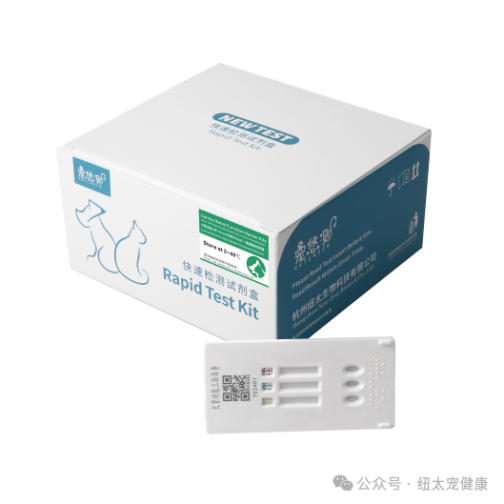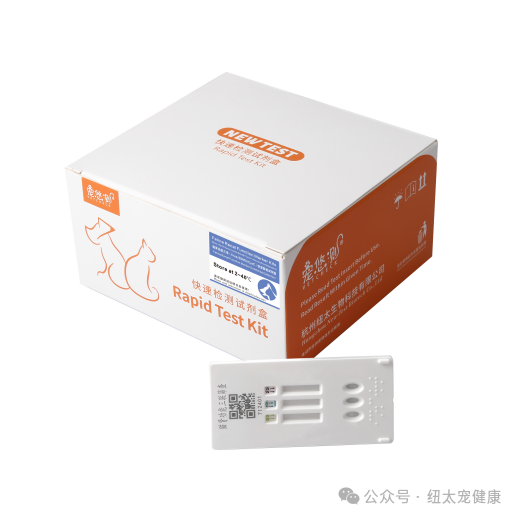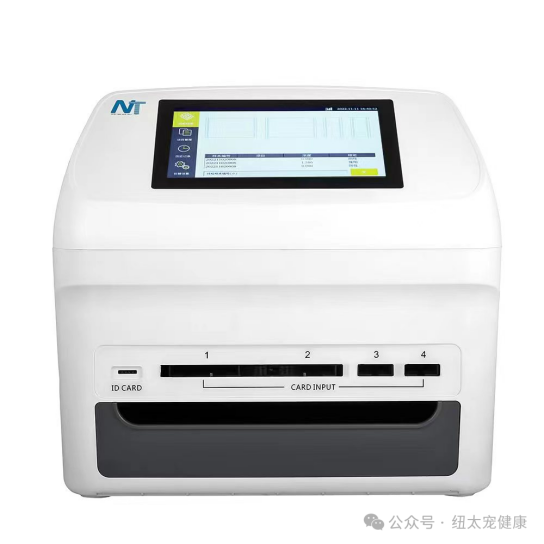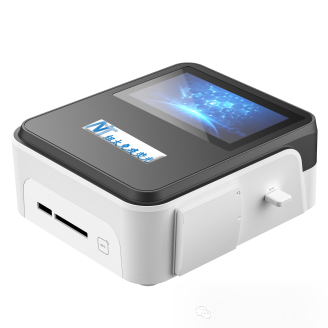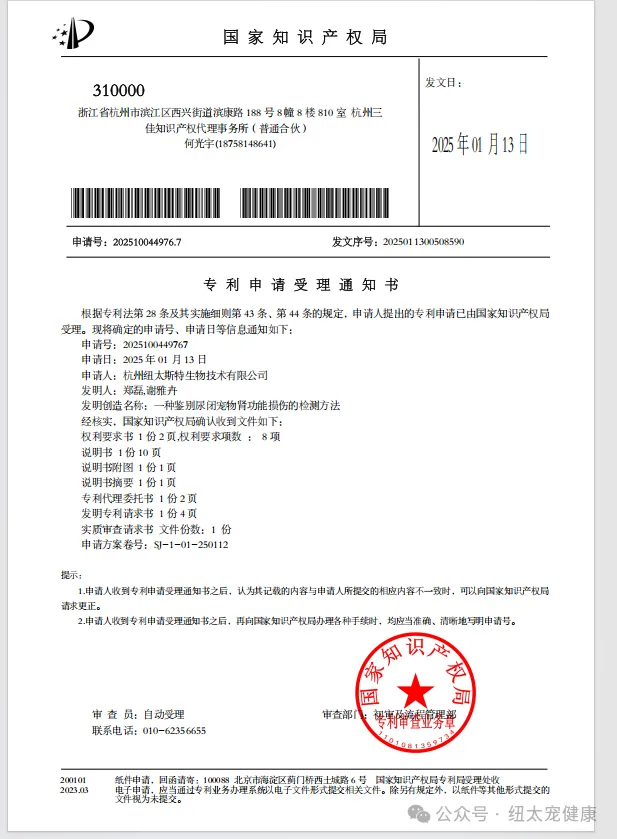Hangzhou New-Test Launches Epoch-making Pet Diagnostic New Product - Canine and Feline Renal Function 3-in-1 combo Test Kit
Hangzhou New-Test Biotechnology Co., Ltd. officially announced the launch of two epoch-making new pet diagnostic products to the global pet immuno-diagnostic market: the Canine/Feline renal function Triple Test Kit (Creatinine/SDMA/CysC Triple Test) (Fig. 1 and Fig. 2), which brings a new and precise solution to pet health diagnostics and treatment.
Figure 1 Canine renal function triple test kit Figure 2 Feline renal function triple test kit
In October 2022, New-Test Biotechnology Co., Ltd. was the first to launch the world's first multi-channel multiplex fluorescence immunoassay analyzer, NTIMM4 (third generation, see Figure 3), and in 2024, the new single-channel multiplex immunofluorescence analyzer, NTIMM2 (fourth generation, see Figure 4). The latest canine/feline renal function 3-in-1 combo test kit is compatible with both models.
Figure 3 NTIMM4 Figure 4 NTIMM2
Specializing in small molecule assay research and development for six years, new products are launched.
The accuracy of small molecule detection has always been a challenge to overcome in the field of POCT testing, and it is also the direction of research and development that Nest-Test Bio has been dedicated to since its establishment more than 6 years ago. The physical quenching and decaying characteristics of traditional fluorescent materials directly affect the accuracy of small molecule detection results. Rare-earth nanocrystal labeling technology, the fourth generation of fluorescent nanomaterials developed by New-Test, is recognized as the most stable fluorescent nanomaterials in the market, which has the advantage of overcoming the physical characteristics of light quenching. Coupled with several years of continuous optimization of the process, it has finally solved the worldwide problem of poor accuracy in POCT small molecule testing. The first push is the kidney function triple test kit. It guarantees the accuracy and stability of the two small molecules (creatinine & SDMA) detection reagents within a 2-year validity period.
“ The single test is also available, so why develop a renal function triad”——Background of the development of the renal function triad
Currently, the common indicators of abnormal kidney function in dogs and cats include creatinine (CREA) and urea nitrogen in biochemistry; CysC (cystatin C) and symmetric dimethylarginine (SDMA) in immunity indicators, etc. At present, it is generally believed that all the above - mentioned indicators are filtered through the glomerulus. When the glomerular filtration rate decreases due to kidney injury, these indicators will accumulate in the blood and increase in concentration, thus reflecting the degree of renal - function impairment. The International Society for Research in Kidney Diseases (IRIS) grading system categorizes renal impairment in cats into four grades based on the value of creatinine (Grade I, normal or mild: <1.6 mg/dL; Grade II, moderate: 1.6-2.8 mg/dL; Grade III, severe: 2.8-5.0 mg/dL; and Grade IV, end-stage: >5.0 mg/dL).
Renal impairment in dogs is categorized into four grades (Grade I, normal or mild: <1.4 mg/dL: Grade II, moderate: 1.4-2.0 mg/dL: Grade III, severe: 2.0-4.0 mg/dL: Grade IV, and end-stage: >4.0 mg/dL). However, due to the limited sensitivity of creatinine in early chronic kidney disease (CKD), another even earlier indicator of nephron function filtration, “symmetric dimethylarginine (SDMA)”, was utilized. According to the data, SDMA can show abnormalities at 25-40% of renal impairment, while creatinine is usually considered to be abnormal at 75% of impairment.
CysC (cystatin C) is a cysteine protease inhibitor, a low molecular weight (13.3 kD), non-glycosylated basic protein. It is one of the most widely used markers of early renal function in human medicine. Like creatinine and SDMA, it is filtered through the glomerulus, but differs from creatinine and SDMA in that its metabolism is not via the urinary tract, but is almost entirely metabolized by reabsorption through the renal tubules.It is this subtle but important difference that has not been previously noticed, leading many scholars, experts and literature to two distinct conclusions about chronic kidney injury in cats: some believe that CysC is an early marker of chronic kidney injury that can be used in both dogs and cats, whereas others believe that CysC correlates moderately well in canine CKD, but poorly in cats.
Why are there two opposite conclusions from the same “glomerular filtration function index”?
The reason is Anuria, which is a condition more prevalent in cats than in other species, especially in male cats. Some data show that the incidence of Anuria in male cats is as high as 68.6%, and Anuria will directly result in obstruction of excretion of creatinine, blood urea nitrogen and SDMA. The organism is constantly metabolizing and producing new creatinine, blood urea nitrogen and SDMA, when detecting all three indicators in the blood at this time, there will be a sharp increase or even a burst of indicators no matter whether the glomerulus is really damaged.
CysC has its unique value at this time, although this indicator is glomerular filtration, it is not metabolized by urine, it is through the tubular for reabsorption. When Anuria happens but the renal function is normal, the CysC index can still be maintained at a normal level. Only when glomerulus or tubular damage really occurs, the CysC index will be elevated to abnormal. Therefore, detection of all three indexes can make accurate diagnosis and provide the corresponding treatment more quickly and efficiently.
New-Test renal function marker 3-in-1 test kits give new clinical significance to the detection of renal injury in dogs and cats!
Explaining the principles and combining with the characteristics of indicators, the New-Test renal function marker 3-in-1 test kits were born with significant clinical significance for dogs and cats (especially cats) with Anuria:
New-Test renal function marker 3-in-1 test kits are used to distinguish whether there is real renal function injury in Anuria condition or resulting in blockage elevation of indexes because of Anuria. Real renal function injury requires only urinary catheterization and related care, and the prognosis is generally better. The blockage elevation of indexes requires not only urinary catheterization and anti-inflammatory treatment, but also related treatment with renal disease, and the prognosis is relatively troublesome, and it is very likely to turn into chronic kidney disease.
Below are the New-Test renal function marker 3-in-1 test kits data for typical Anuria (Non-real kidney injury) and Anuria + kidney injury in New-Test clinical research cases:
| Anuria detection New-Test renal function marker 3-in-1 test kits |
Project |
Result |
Result |
|
Creatinine |
+ |
+ |
|
|
SDMA |
+ |
+ |
|
|
CysC |
+ |
- |
|
|
Conclusion |
Anuria has resulted in renal injury | Early stage of Anuria and renal injury or Anuria that has not yet reached renal injury |
Below are part of typical clinical data and case description of the New-Test renal function 3-in-1 test kits:
|
Cat |
Medical History |
Clinical Symptom |
CysC(mg/L) |
SDHA (ug/dL) |
CR(mg/dL) |
Conclusion |
|
2024090902 |
Cystitis/Acute renal injury |
Bad mental state, Lose appetite, Abnormal renal index, Anuria (Chronic renal failure, anuria) |
1.09 |
86.47 |
8.18 |
Renal injury with Anuria |
|
2024091201 |
/ |
Bad mental state, Anuria, Abnormal renal function |
0.51 |
27.44 |
8.21 |
No renal injury with Anuria/Early stage |
|
2024092702 |
/ |
Anuria |
0.31 |
>100.00 |
9.04 |
No renal injury with Anuria/Early stage |
|
2024103101 |
/ |
Anuria |
0.3 |
14.11 |
6.52 |
No renal injury with Anuria/Early stage |
|
2024112712 |
Anuria |
0.5 |
>100.00 |
8.85 |
No renal injury with Anuria/Early stage |
|
|
2024112601 |
Dysuria/Anuria |
0.43 |
>100.00 |
9.06 |
No renal injury with Anuria/Early stage |
|
|
0.47 |
>100.00 |
878 |
No renal injury with Anuria/Early stage |
|||
|
2024112712 |
/ |
Anuria |
0.54 |
94.03 |
8.64 |
No renal injury with Anuria/Early stage |
In the condition of Anuria, due to differences in the internal metabolic mechanism of each index, there will be result in large differences for same renal function filtration index. Therefore, conventional classification of renal injury of creatinine or SDMA is no longer applicable, and the closest clinical conclusion can only be obtained by combining the analysis with another indicator “CysC”. It is recommended that laboratories (hospitals) establish internal standards based on clinical experience, so as to explore more and newer clinical significance.
Finally, New-Test Biotech hopes that this article will throw out a brick to attract a jade, and hopes that more Chinese veterinary drug and diagnostic reagent manufacturers will develop more clinically significant products and assist more domestic clinical veterinarians to reach the top level in the world!
Appendix: Acceptance of Patent Application for Intellectual Property Protection
Post time: Jan-22-2025

